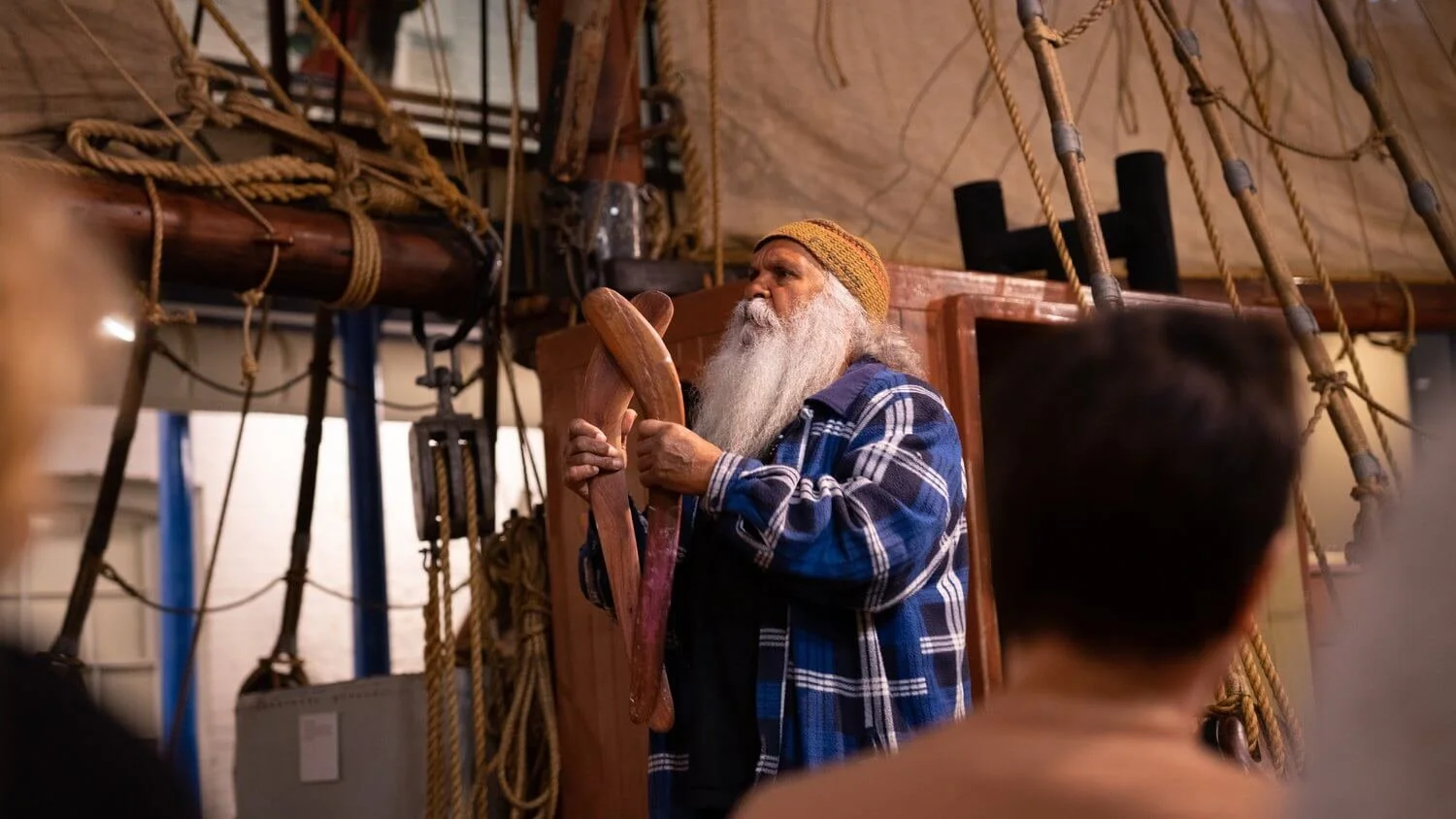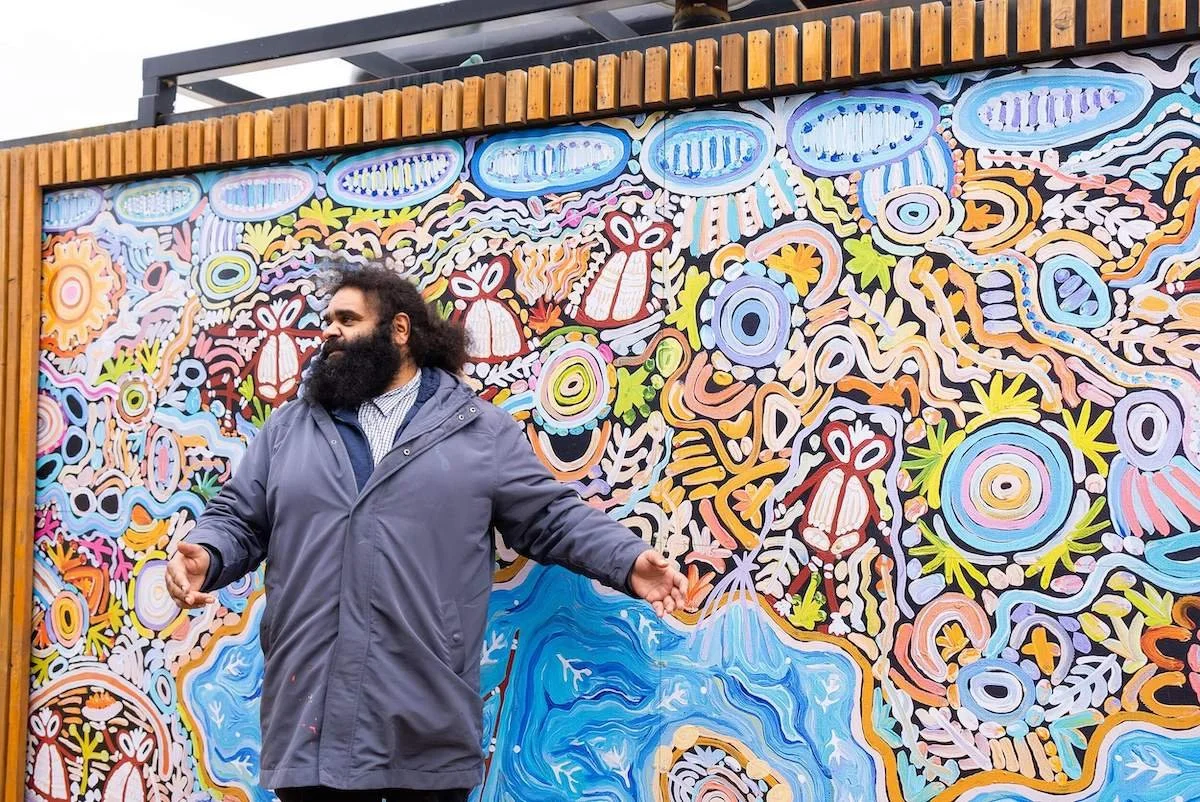On Country: Decolonising Design
As a certified B-Corp and purpose-led brand marketing agency, respectful design is at the heart of every Green Island Creative project.
Ngarrindjeri elder Major Sumner welcomes audiences to Sea Country Stories at the SA Maritime Museum
Increasingly, we are honoured to work on and be involved with creative projects that centre Aboriginal and Torres Strait Islander histories, languages and cultures. Our new exhibit Sea Country Stories housed in the South Australian Maritime Museum, alongside education work with Kuti Co. pipi fishery and a Dharawal Language Lesson for the Marine Stewardship Council offer a few examples of this work.
As non-Indigenous Australians working in this space, we became curious about what are best practice standards for ‘decolonising design’. In other words, standards for accurate, fair and respectful representation of First Nations cultures in design? The Australian Indigenous Design Charter’s Communication Design (AIDC: CD) offered just what we were after: ten core principles for design practitioners sharing Indigenous knowledge in communication design.
If you are a creator, designer or content maker in Australia, we encourage you to ask questions, listen closely and pay attention to these ten principles. Knowledge is power and knowledge is valuable. So when it comes to the oldest living, continuous culture on Earth, treat knowledge holders and all that they share with the respect and value (and importantly, the financial compensation) they deserve.
What is the Australian Indigenous Design Charter?
Principle 1) The project is Indigenous-led: when representing Indigenous people in design, ensure that they are leading the creation of the project.
How do we do this? We make a point of giving a platform and creative license to Indigenous presenters. We do not script or direct which knowledges or “content” they deem significant, and instead support them to take the stage and share stories in their own voice and way.
Principle 2) The project is self-determined: respect that Indigenous peoples oversee the representation of their culture in design practice with their own free choice.
Principle 3) The project is community-specific: respect the rich and diverse Aboriginal and Torres Strait Islander culture and follow community-specific cultural protocols.
Principle 4) Engage in deep listening: make sure that you are respectful and courteous when personally engaging with Aboriginal and Torres Strait Islander peoples.
Principle 5) Assess the impact of your design: understand the implications of your projects and ensure that they are respectful of Indigenous peoples and their culture.
Principle 6) Can Indigenous knowledges improve certain projects? Even if the project isn’t specifically about Aboriginal and Torres Strait Islander culture, consider if any project can be improved with Indigenous knowledge and voices.
Ngarrindjeri artist Cedric Varcoe talks about the cultural significance of his mural on the Kuti Shack, at a National Science Week event with the Marine Stewardship Council
Principle 7) The project respects shared knowledges: carry out respectful methods for collaboration and acquisition of engagement and sharing of Indigenous knowledge. This means interacting in a considerate way to communicate shared knowledges.
Principle 8) The project is legal and moral: honour cultural ownership and intellectual property rights, including moral rights. Always seek permission to share language, knowledges, and images from the appropriate community bodies, prior to commencing your project.
Principle 9) Create a Reconciliation Action Plan (RAP): A RAP is designed to provide benefits for Aboriginal and Torres Strait Islander peoples and support their self-determination. We’re currently in the process of developing one for Green Island Creative.
Principle 10) We implement the charter: implement the AIDC: CD to protect Indigenous design integrity.
We value the AIDC: CD in our ongoing work with First Nations elders, artists, performers, academics, scientists, storytellers and designers. We’re walking together to ensure support and inclusivity for Aboriginal and Torres Strait Islander peoples, cultures and Countries, today and always.
Suggested Reading
Uncle Charles Moran, Uncle Greg Harrington & Norm Sheehan (2018), On Country Learning, Design & Culture, 10:1, 71-79, DOI: 10.1080/17547075.2018.1430996
Tony Syme (2020), Localizing landscapes: a call for respectful design in Indigenous counter mapping, Information, Communication & Society, 23:8, 1106-1122, DOI: 10.1080/1369118X.2019.1701695
Alison Page and Paul Memmott (2021), Design: Building on Country, Thames and Hudson (Australia)
Michele Lobo (2019), Affective ecologies: Braiding urban worlds in Darwin, Australia, Geoforum, Vol 26, pp. 393-401
Want more? Read our case study
Sea Country Stories
An immersive exhibit at the South Australian Maritime Museum



